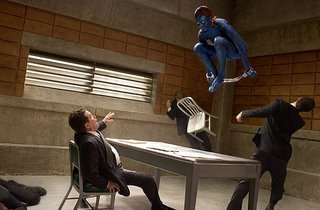Wednesday, June 07, 2006
Grabbing Godzilla by the tail


There are plenty of scenes throughout director Ishiro Hondo’s 1956 film “Godzilla” of the sea monster smashing his long lizard tail atop Tokyo buildings. It’s one of many acts of destruction Godzilla does so well. But the tail I think of when reminiscing about Godzilla has nothing to do with a man in a rubber monster suit stomping atop a model of Tokyo. My mind rests on a simple length of masking tape with the word “Godzilla” stenciled in green marker alongside a cartoon sketch of the famous movie beast. The tape is attached to the final thread of film on the last reel of the uncut, original, Japanese version of the film, which I helped project for a series of shows at a Cincinnati cinematheque.
Film buffs will tell you nothing in the digital video universe compares to celluloid in terms of beauty and richness and they’re right. There’s even more poetry in handling a restored film print of “Godzilla.” Crisscrossing U.S. theaters over the past twelve months, “Godzilla” came to my hands slightly worn and fragile, which made the experience all the more magical. You handle the reels delicately, repairing the few torn frames. For these showings, the advance hype is accurate. This is film history in the making on a private scale. Everyone has childhood memories of their favorite movie monsters; the first time they watched James Whale’s “Frankenstein” or Todd Browning’s “Dracula.”
But the original Japanese version of “Godzilla” never played U.S. theaters until recently. Stripped of the added scenes featuring Raymond Burr’s reporter and the dubbed English, “Godzilla” is sober, solemn and fantastic to watch.
Adult film fans in the crowd appreciate the film’s morality, the seriousness that makes “Godzilla” more than a creature feature. Hondo, a former assistant to Akira Kurosawa, makes the most out of Takashi Shimura’s role as a sympathetic scientist who wants to study the underwater creature blasted awake by an H-bomb explosion.
The theme of man messing with nature is clear in this version of “Godzilla” – as clear as the Al Gore/global warming documentary “An Inconvenient Truth.”
Midway into the film, a young woman is asked if she plans to evacuate Tokyo if Godzilla heads their way. She answers with a definite yes. After all, she survived the bombing of Nagasaki and is not about to jeopardize her life.
Children in the crowds may not instantly connect with the morality of “Godzilla.” They’re more interested in the beast’s path of destruction, his first appearance above a rural hillside and his fiery demolition of Tokyo.
Granted, the man in the rubber lizard suit looks clumsy to children accustomed to the computerized special effects of “Harry Potter” and “The Chronicles of Narnia.”
The clever way Honda keeps Godzilla hidden in nighttime skies is lost on movie kids who want to see everything. A swishing tail crashing against Tokyo apartment buildings doesn’t cut it. After watching the movie, my seven-year-old son promptly declared the movie as “lame.” Godzilla, he told the people exiting the cinema, just wasn’t scary enough.
Of course, that didn’t stop him from having nightmares later that night.
.
Monday, June 05, 2006
X-Men to the World: Take Us Seriously!

Godzilla – Monster-sized Movies that can’t be ignored
The Golden Gate Bridge rises off its moorings and levitates across San Francisco Bay. Cars fly across mountain highways and burst into flames. A winged teenager crashes through a skyscraper window and soars above the city skyline. The perpetrators of these fantastic feats are the costumed heroes and villains of “X-Men: The Last Stand,” the third movie blockbuster based on the popular comic book.
The X-Men formula of mutant teenagers with fantastic powers, one controls the weather, another can move through walls, battling baddies with their own superhuman skills is rock solid action formula.
“X3,” directed by Brett Ratner, has sold $175.7 million worth of tickets in the U.S. in its first ten days of release, meaning that a lot of teenage movies goers are returning again and again.
“X3” may also have just enough thrills to please that ardent art-house film buff in need of a movie void of any intellectual engagement.
“X3,” boasting a villain named Juggernaut who crashes through cement walls like a human bulldozer, offers a sugary rush at all its best moments but there are some who look beyond the explosions.
On a May 30 “National Public Radio” story, commentator Mike Pesca says the “mutantism” in “X3” represents real-life issues ranging from dwarfism to deafness and sexual orientation. He’s not the first person to place sociopolitical issues atop the film’s constant special effects. “X3” actors have been discussing the film’s human rights philosophy during their pre-release publicity appearances. Halle Berry, who plays the X-Men leader Storm, flashes eerie white eyes that match her dyed hair whenever she uses her powers to manipulate the weather. Toss in Berry’s body-hugging leather jumpsuit and it’s almost impossible to take her seriously. Sometimes, a comic is simply a comic. Any political debate around “X3” feels like an awkward stretch.